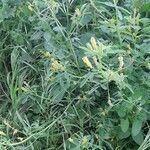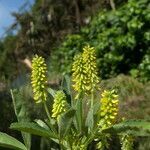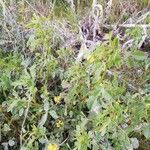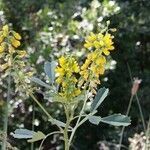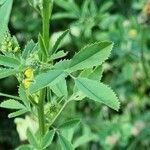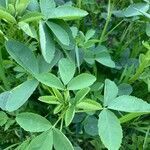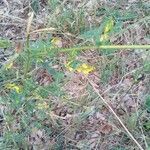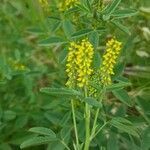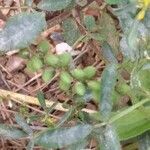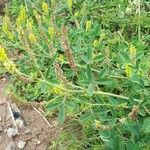Erect or ascending annual up to 0.6 m high; stems ± glabrous or sparsely hairy in upper parts. Lvs usually ± glabrous, sometimes sparsely or moderately hairy particularly when young; petioles c. 5-25 mm long; leaflets elliptic to obovate, usually obtuse, sometimes slightly emarginate or acute, usually shortly mucronate, obtuse to cuneate at base, serrate, c. 6-25 mm long; stipules lanceolate, entire or obscurely dentate at base. Racemes slender, dense at flowering and sometimes at fruiting but often elongated up to 12 cm at fruiting; fls (10)-numerous. Peduncles usually > petioles. Calyx ± glabrous or sparsely hairy; calyx teeth > tube, subulate. Corolla yellow, becoming white with age, 2-3 mm long; wings ± = keel. Pod glabrous, reticulately veined, 2-3-(4) mm long, 1-2-seeded; seeds light brown, 1.5-2 mm long.
An erect, branching, sparingly pilose annual.. Stipules often with a small tooth near the base; petiole up to 2 cm. long; rhachis ± 5 mm. long; leaflets cuneate-oblong or lanceolate, up to 25 mm. long by 9 mm. wide, coarsely toothed, rounded at the apex.. Racemes many-flowered, up to 10 cm. long, including a peduncle of up to 3 cm.; bracts subulate, ± 0·5 mm. long; pedicels ± 1 mm. long, reflexed after flowering.. Calyx ± 1·5 mm.. Corolla yellow, ± 2·5 mm. long.. Style 0·9–1·2 mm. long.. Pod 3–4 mm. by 2–3 mm., 1-seeded, with prominent reticulate veins.. Fig. 145/1–8.
An annual herb. It is erect and without hairs. It grows 60 cm high. The leaves are alternate and made up of 3 leaflets. They are 12-30 mm long. The flowers are yellow and pea-like. They are 2 mm long. They are clustered on stalks which arise from the bases of the leaves. The fruit is a round, slightly wrinkled pod. It is 2-2.5 mm long by 1.5-1.7 mm wide. It is olive green. It has one seed. The plant has a sweet scent.
Ascending or erect annual 2–6 dm; racemes very densely fld, 3–8 cm; pedicels at anthesis 0.5–0.8 mm, ascending; fls yellow, 2–3 mm; cal-teeth lance-oblong, obtuse; fr 1.5–3 mm, strongly reticulate-veiny; otherwise as no. 2 [Melilotus officinalis (L.) Pall.]; 2n=16. Native of the Mediterranean region, now a cosmopolitan weed, abundant in the s. and Pacific states, and adventive in our range. Summer.
Erect or sprawling annual or biennial, up to 0.5(-1) m tall. Leaves 3-foliolate, petioles slender, leaflets obovate or narrowly obovate, truncate to notched, margins minutely toothed. Flowers minute, clustered in slender, long, pedunculate racemes, yellow. Pod small, ± ovoid, inflated to slightly compressed, surface wrinkled.
Annual herb, up to 1.2 m high; much branched. Leaves with finely toothed leaflets, rounded at apex; stipules often with a small tooth near base. Flowers: in many-flowered racemes; style 0.9-1.2 mm long; corolla yellow; Aug.-Nov. Pods predominantly reticulate-veined with a prominent, irregular network of veins, 2-3 mm long.
Annual, erect, branching shrub with pilose stem. Leaves trifoliolate. Leaflets cuneate-oblong or lanceolate with rounded apex, roughly toothed. Stipules denticulate near base. Inflorescences many-flowered racemes. Flowers yellow. Flowering time Oct.-Jan. Pod 1-seeded, prominent reticulate veins.
Leaflets up to 25 × 9 mm, shortly cuneate-oblong or lanceolate, rounded at the apex, denticulate around the upper half or more; stipules lanceolate-subulate, entire, sometimes denticulate near the base.
Corolla yellow, ± twice as long as the calyx; standard c. 2.5 mm long, emarginate at apex; wings subequalling the keel, with small auricles; keel c. 2 mm long.
Racemes slender, many-flowered, at first compact and cylindrical, later elongating and laxer; peduncle up to 3 cm long.
Pod 2–3 mm long, globose-ovoid, strongly reticulately veined, 1-seeded.
Calyx c. 1 mm long; teeth narrowly deltoid, subequal, thinly hairy.
Flowers with pedicels c. 1 mm long, reflexed in fruit.
Erect, much branched, slender annual herb.
Seeds ovoid, finely verrucose.
